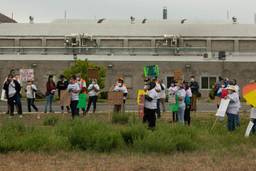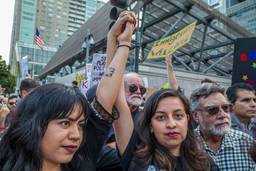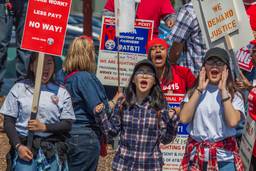All photos taken by David Bacon in Oakland, Calif., between August 21 and 28, 2009.
Everyone knows Oakland, Calif., is a diverse community. Probably more people from more races and nationalities live in the city than anywhere west of New York or north of Los Angeles.
But before we celebrate diversity, think of its most diverse places. Some of them are surely the lines of hungry people lining up for food.
Four food pantries, one city
Oakland has many food pantries — programs run mostly by churches on a shoestring. Church elders are often found at the Alameda County Community Food Bank’s huge warehouse out by the airport, searching for ways to stretch their donations into the bags they know will run out when the people line up.
Reverend Lee from the Cornerstone Baptist Church, a food bank stalwart, fills the small storefront with white plastic bags of cans, dried goods and bread. Then the people come. Mostly Chinese-American and African-American families here get their food from the African-American activists from his church.
On the other side of the airport, in a park by the freeway sound wall next to the 98th Avenue exit, a very diverse group of Asian, Black, Latino and white folks bag up fruit and vegetables. Early in the morning, families — mostly Mexican immigrants — arrive to get numbers and wait. After the big food bank truck unloads and the baggers begin work, Columbian Gardens breathes a sigh of relief as people once again have food for the coming week.
Early morning is the arrival time also for the Good Samaritan food pantry, in the close-in neighborhood of East Oakland some folks call New Chinatown. Older Chinese immigrant women line up their shopping carts, and sit and stand on the sidewalk across the street from a small, ramshackle house filled with food. Then, joined by African Americans and Latinos, they trade numbers for bags, and patiently surround huge cardboard bins of lettuce, cucumbers and pears.
A growing problem — in Oakland and throughout America
A third of the people in Oakland’s hungry families are younger than 18, and a quarter are over 50. With Oakland’s unemployment rate over 12%, less than a quarter of food pantry clients get most of their income from a job, although probably most work.
Just a look at the people in line tells you the basic facts behnd the numbers, however. Oakland has thousands of families who don’t have enough to eat — of all races and nationalities.
Today, the number of people in America needing emergency food is higher than ever. Food insecurity hits 35% of low-income households. In 2002, 34.9 million people were food insecure, up 1.26 million from 2001. African-American and Hispanic American households suffered the worst rates of hunger and food insecurity, with 22% and 21.7%, respectively. Among the hungry, 39.1% are male, while 60% are female.
African-American single-mother households experience the greatest threat of hunger, with a 73% chance of food insecurity. Studies show that money which is devoted to food is the most elastic part of a family’s budget, as limited funds usually get allocated to fixed payments first, such as rent and utilities.
Because of an increase in the nation’s poverty rate, this means food purchasing is the most compromised portion of the average family’s budget. In 2004, 35% of Americans had to choose between food and rent, while 28% had to choose between medical care and food. Those percentages are undoubtedly higher today, as the U.S. economy struggles to emerge from the greatest financial crisis since the Great Depression.







